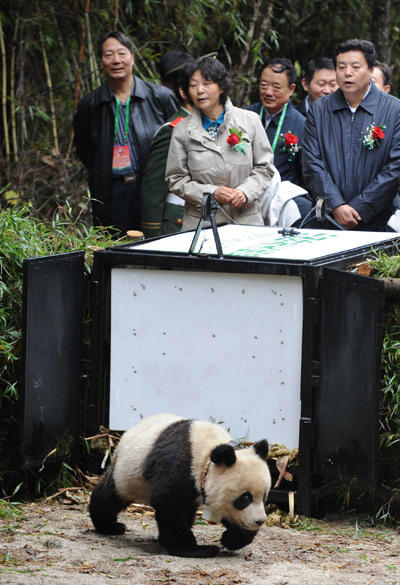|
 |
|
SET FREE: Visitors at the Wolong Nature Reserve in southwest China's Sichuan Province watch as Taotao, an artificially bred panda, is released to the wild on October 11 (LI QIAOQIAO) |
People are so accustomed to seeing China's national treasure, the giant panda, immersed in well-protected environments that few can imagine the lovable creatures struggling to survive in the wilderness among all of nature's predators.
But it is precisely that untamed wilderness where pandas belong, and China is making efforts to send the majority of pandas in captivity back to their original homes.
On October 11, Taotao, a 2-year-old artificially bred panda was released to the wild in the Wolong Nature Reserve in southwest China's Sichuan Province, marking a significant progress in the country's wilderness survival program for the black-and-white mammal.
Zhang Hemin, chief of the Wolong reserve, was among the first to advocate sending pandas back into the wild.
After graduating from Sichuan University in 1983 with a degree in biology, Zhang joined the Wolong Giant Panda Research and Conservation Center that same year and began studying panda propagation.
"At that time, the Wolong Nature Reserve was home to only 10 pandas, and this number increased to 119 in 2006," Zhang said. "Among them, 94 were propagated artificially, accounting for about 50 percent of all pandas in captivity in the world."
This has brought new problems. According to Zhang, the separation of habitats due to human activities has fragmented the wild population of pandas, which has limited mating options and led to a high possibility of inbreeding.
"Releasing pandas to the wild is the best way to deal with these problems, although it is pretty tough," Zhang said, despite the fact that China has successfully released more than 20 species of animals into the wild over the past two decades, including the crested ibis, Chinese alligator, elk, wild horse, Tarim red deer and yellow-bellied tragopan. "It's far more difficult to release pandas into the wild due to their low birth rate, uniform diet and fragmented habitat."
In 2003, Xiangxiang, a 2-year-old male panda, was selected as the strongest candidate to be the country's first wilderness survival program for panda. Before his release, Xiangxiang had to pass through three phases of training: learning to find food by himself, climbing up trees, and recognizing natural enemies and protecting himself.
After almost three years, Xiangxiang was taken into the mountainous Wuyipeng area of the Wolong Nature Reserve, home to more than 10 wild pandas. A team of experts were able to track his activities through a GPS tag attached to his collar.
On December 13, 2006, the radio positioning system showed Xiangxiang had suddenly traveled a long distance. Nine days later, researchers found him with injuries on his back and his hind feet.
After receiving treatment at the base for 17 days, the animal was re-released on December 30. But the radio signal again became weak on January 7, 2007, and then disappeared. More than one month later, Xiangxiang's body was found in the woods on February 19. He had a broken rib, injuries to his ears and a large wound on his back. Researchers suspected he had taken refuge in a tree after a fight with wild pandas, but then had fallen to his death.
Xiangxiang's death was a heavy blow to workers at the Wolong Nature Reserve, and Zhang was soon at the center of harsh controversy. The training program was later suspended due to the Wenchuan earthquake that occurred in May 2008.
The Wolong Nature Reserve's Hetaoping base was destroyed in the magnitude-8 tremor and its pandas were relocated to the Bifengxia base in nearby Yaan.
Zhang, despite the failure for the first time, insisted on the program. "This is the best time for releasing pandas back to the wild," said Zhang, who further explained that the number of captive-bred pandas has already reached a reasonable level to meet reproduction needs and the living environment of wild pandas has improved a lot as well. "Only when the pandas survive in the wild and grow to a bigger group can we save this breed from the distinction line."
| 